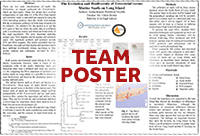

- Program:
- Urban Barcode Research Project
- Year:
- 2019-20
- Research Topic:
- Biodiversity & trade
- Taxonomic Group Studied:
- Plants
Project:
Aldrovanda research
- Students:
- Deborah George, Alex Garcia
- Institution:
- American Museum of Natural History, Manhattan
- Mentors:
- Michael Tessler
Abstract:
Aldrovanda vesiculosa, a rootless, aquatic, carnivorous plant, has recently concerned conservationists after its introduction to the Eastern United States. It was introduced in an attempt to preserve the species since it is endangered in its native range: the Eastern Hemisphere. Many are worried about how the spread of A. vesiculosa could negatively impact the biodiversity of the eastern United States. Given this, our research first attempted to determine if A. vesiculosa is becoming an ecological threat based on what invertebrates it is eating. Our second goal was to use Species Distribution Modeling (SDM) to determine where in the northeastern United States A. vesiculosa could potentially spread to. To achieve this, we used amplicon sequencing of the COI gene to identify partially digested prey items. Additionally, we used microscopes to morphologically identify prey from samples. As much of the DNA was damaged (digested), the metabarcoding returned only a few po

